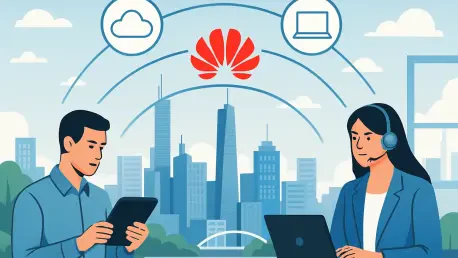In an era where digital connectivity is often taken for granted in urban centers, billions of people in remote and underserved regions remain cut off from the benefits of the internet, struggling with barriers like unstable power and high costs. This digital divide, as highlighted by global statistics from organizations like GSMA, affects over 3 billion individuals who, despite living within mobile network coverage, cannot access digital services due to affordability and infrastructure challenges. The implications are profound, limiting access to education, healthcare, and economic opportunities. Addressing this gap is not just a technological challenge but a critical step toward achieving global equity and supporting the United Nations’ Sustainable Development Goals by 2030. Huawei, a major player in telecommunications, has stepped up with innovative solutions tailored for these hard-to-reach areas, offering a glimpse of hope through enhanced connectivity and inclusive services that empower communities in crisis-prone and rural regions across the globe.
Revolutionizing Connectivity with Resilient Solutions
The harsh realities of remote environments, where natural disasters and conflict often disrupt essential services, demand robust technological interventions to maintain connectivity. In regions like South Sudan, where base station outages exceed alarming rates due to extreme weather and instability, Huawei’s Single SitePower Solution emerges as a game-changer. This technology integrates an intelligent RAN management system that acts as a predictive tool, analyzing real-time meteorological data to adapt operations during adverse conditions. By switching to energy-saving modes during the rainy season, the system ensures that critical communication lines stay active. This resilience has proven vital during health crises, such as malaria outbreaks, where timely access to medical care within a narrow time frame can mean the difference between life and death. The ability to maintain network stability in such challenging settings not only supports emergency responses but also builds a foundation for trust in digital infrastructure among vulnerable populations who rely on it most.
Beyond immediate crisis response, the impact of stable connectivity extends to long-term community benefits, particularly in areas prone to isolation. The sustained operation of mobile networks in remote locales ensures that essential services remain accessible even when physical infrastructure is compromised. Huawei’s approach focuses on fortifying base stations against environmental challenges, reducing downtime significantly. This means that rural communities can depend on consistent communication channels to coordinate aid, access vital information, and connect with distant support networks. Such reliability fosters a sense of security and inclusion, allowing residents to engage with the broader world without the constant fear of being cut off. Moreover, this technological backbone supports local governance and humanitarian efforts by enabling real-time data sharing and coordination, which are crucial for effective disaster management and recovery initiatives in regions where every second counts.
Empowering Education Through Digital Access
Education, a cornerstone of societal progress, often suffers in remote areas due to seasonal disruptions and lack of resources, disproportionately affecting young girls. In countries like Côte d’Ivoire, where heavy rains contribute to high dropout rates, Huawei has implemented intelligent systems to counter these challenges. Tools like the Intelligent Site Health Inspection and FME Mate optimize power usage and predict network traffic, ensuring backup energy availability during harsh weather. This has led to a remarkable reduction in network outages across numerous villages, allowing remote learning platforms to function without interruption. The result is a significant boost in school continuation rates for girls, empowering them with digital skills and access to education that was previously out of reach. This stability transforms the learning landscape, making it possible for students to engage with online resources and maintain academic progress despite environmental hurdles.
The broader implications of reliable digital access for education are transformative, especially in fostering gender equity and skill development in rural settings. By ensuring that networks remain operational, Huawei’s solutions enable educators to deliver consistent instruction through virtual classrooms, bridging geographical barriers. This is particularly impactful for young women, who often face additional societal pressures to abandon schooling. With access to online learning, they can pursue studies from home during periods when travel to school is impossible, thus reducing dropout risks. Furthermore, exposure to digital tools equips students with essential skills for the modern workforce, preparing them for future opportunities that extend beyond their immediate surroundings. This educational empowerment not only uplifts individuals but also strengthens entire communities by cultivating a more informed and capable generation ready to tackle local and global challenges.
Driving Economic Growth with Inclusive Services
Economic stagnation in remote areas often stems from limited access to basic digital tools, a barrier that Huawei addresses through innovative service points. In Cameroon’s northwest highlands, where many struggle with uncharged devices, base stations powered by intelligent energy modules provide affordable mobile charging at a nominal fee. These points go beyond basic functionality, offering services like SIM card top-ups and device sales, which spark local economic activity. Women, in particular, benefit by connecting with urban markets to sell agricultural products at significantly higher prices, boosting their daily earnings. This additional income often covers essential expenses like school fees for multiple children, illustrating how small-scale digital access can catalyze substantial financial improvements for families in underserved regions, thereby narrowing the economic divide.
The ripple effects of such economic initiatives are felt across entire communities, as digital inclusion fosters entrepreneurship and market expansion. By providing the means to charge devices and access mobile services, Huawei’s solutions enable rural residents to participate in broader economic networks. Farmers and small-scale vendors can now negotiate better deals, track market trends, and reach customers far beyond local boundaries. This connectivity also attracts small business investments, as reliable communication reduces operational risks in remote areas. Over time, these service points become hubs of activity, encouraging the exchange of goods, services, and information. The resulting economic upliftment strengthens community resilience, as increased earnings translate into improved living standards, better access to education, and enhanced healthcare—key components of sustainable development that align with global goals for equitable growth.
Building a Sustainable Future Through Digital Inclusion
Reflecting on the strides made, Huawei’s efforts to enhance connectivity in remote regions have delivered measurable outcomes, from life-saving communication during crises to educational advancements and economic empowerment. These initiatives, rolled out in diverse settings like South Sudan, Côte d’Ivoire, and Cameroon, showcase the adaptability of tailored technological solutions in addressing unique local challenges. The reduction in network outages and the provision of affordable digital access mark significant progress in closing the usage gap that once isolated billions.
Looking ahead, the focus should shift to scaling these solutions to reach even more underserved populations, ensuring that technological advancements continue to align with sustainable development objectives. Collaboration between tech innovators, local governments, and international bodies will be essential to replicate and adapt these models globally. Prioritizing investment in resilient infrastructure and inclusive services can further dismantle barriers, paving the way for a connected world where digital equity drives socio-economic transformation for all.









